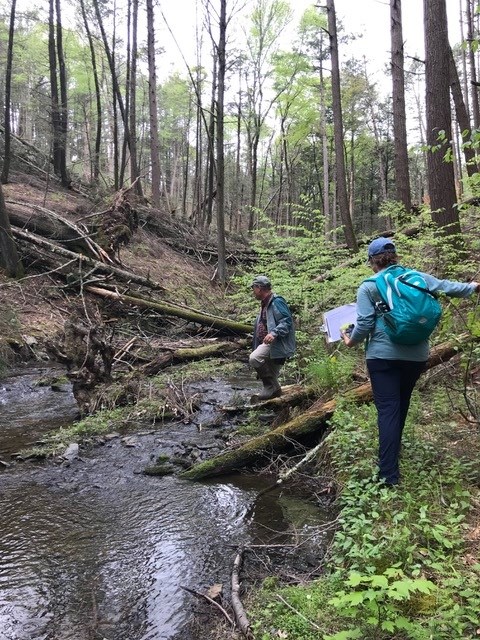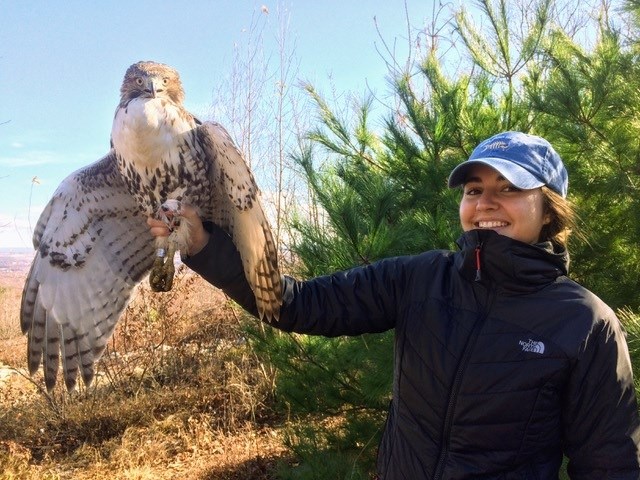Searching for Two Secretive Forest-Raptors
Posted on in In the Field by Lauren Sarnese, Goshawk and Broadwing Project Field Assistant 2018

Working on the Pennsylvania Goshawk and Broad-winged Hawk projects has given me a whole new set of experiences and has opened my eyes to a different sector of field work. My degree is in biology with a personal focus in entomology from East Stroudsburg University (Spring 2016). Coming into this, I had no experience with raptors, but I did come with enthusiasm, passion, and a general love for ecology.
It began with sifting through gear lent to me by Hawk Mountain—a plethora of technical resources mixed with lists of places and names I had never heard before. Dr. Laurie Goodrich and Rebecca McCabe helped prepare us for the upcoming field season with a training session at the Sanctuary. I took notes and wrote down names and dates in preparation to make calls and schedule site visits for the upcoming weeks. As the end of March approached, I was eager to get out in the field and start searching for these raptors.
The field season began with nest-searching for northern goshawks. Being inexperienced, I was pointing out squirrels’ nests, insignificant stick clusters, and nests that I now know would crumble under the weight of a goshawk. Over time, I developed an eye for large nests, large birds, and an ear for raptors (and maybe a few passerines). The work always gave me more energy than it took from me, which is how I classify a passion. It became increasingly more exciting with each new thing I saw; I became hyper-focused when looking for nests and listening for raptors.

The first day conducting goshawk broadcast surveys was wonderful and challenging! As to be expected for the northern part of the Pocono Mountains, the terrain was rough. The surveys were interesting in a way that they challenged you to pay attention to all visual and aural details of your surroundings in a fixed period of time. The anticipation was much like fishing: you don’t know if you’ll catch anything, but if you do, it’s a stellar day! This mindset persisted and carried us through the rough terrain, and there was only a minor mishap of accidentally spraying my former professor with bear spray.
However, at the fourth broadcast point (a total of 19 were done at each historical site), we got a response. That initial callback gave us all an electric amount of energy; this was what being in the field was about! We continued forward in hopes of crossing paths with this elusive creature that I had yet to see. We played more calls but those few responses were all we were fortunate enough to hear that day. The excitement was still overflowing as we finished the survey and walked to the car anxious to call Laurie. She, being equally as excited, immediately reached out to Chelsea, a Penn State graduate student overseeing goshawk surveys statewide, who instructed us to schedule another day of searching at that site.
During the time of Goshawk broadcast surveys, I also began searching for broad- winged hawk nests in the Delaware State Forest. This was definitely a learning curve for me. Spotting a broad-winged hawk female on the nest was more difficult than I anticipated. She would hunker down only looking at me with one eye. If you were lucky, her tail might have been sticking out of the nest too. The broad-winged hawks were equally as exciting and easier to find than the goshawks. I found myself attempting to anticipate their movements, so I could track them back to their nests in hopes of finding a female incubating.

Working on both projects, I gained so many unique skills that will carry me through my career as a biologist. I developed relationships with foresters, private landowners, and, of course, the wonderful team at Hawk Mountain. I am so grateful to have had the opportunity to work with such a fantastic organization and team. I look forward to seeing all of the ecological advancements they make in the future.
Click to learn more about Hawk Mountain's PA Goshawk Project and Broad-winged Hawk Project, and how you can support these efforts.